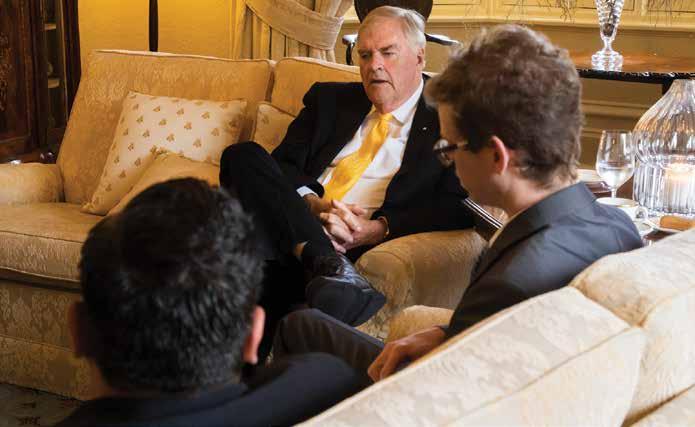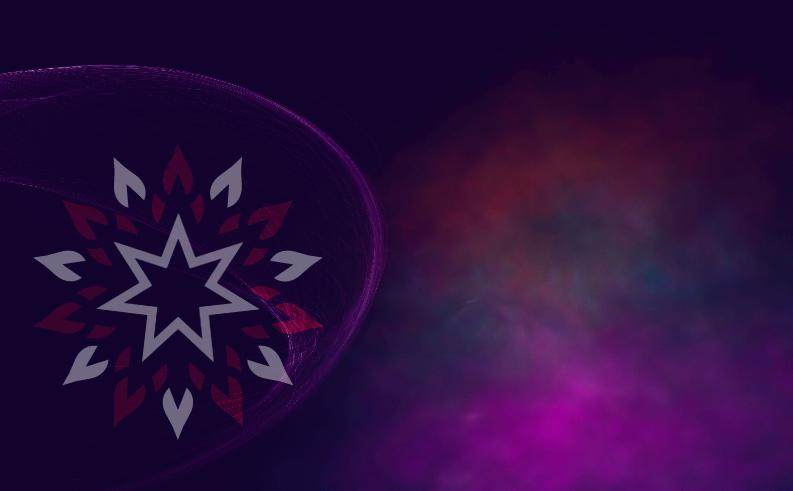
17 minute read
EXCLUSIVE INTERVIEW
By Stephen Bunce,
Defence Writer, WA DEFENCE REVIEW &
Serge DeSilvaRanasinghe,
Managing Editor, WA DEFENCE REVIEW
THE HON KIM BEAZLEY: “MORE AND MORE FOCUS WILL COME ON TO WESTERN AUSTRALIA, OUR STRATEGIC CONCERNS, AND OUR STRATEGIC GEOGRAPHY.”
In August WA DEFENCE REVIEW had the pleasure of visiting Government House to conduct an exclusive interview with the Governor of Western Australia, the Hon Kim Beazley AC. The Governor’s impressive experience and knowledge of defence and keen understanding of the complex strategic issues key to the peace and prosperity of Australia and the region, made for a fascinating and insightful conversation.
How would you describe the circumstances of Australia’s present strategic challenges? Where are we at right now?
Australia is facing a more difficult situation than we have seen for a very long time and must think through the requirements of our national security with a maturity that we have not had to before. In the 1930s when we were faced with a survival threat, we considered ourselves under the umbrella of the British Empire defence, so there wasn’t the same sort of pressure on the leadership of the country. It was very difficult for that threat to be conceptualised by those who had responsibility for Australia’s defence. Now, however, Australia is intellectually up to the challenge and thoroughly aware of the extent to which we ourselves must look after our concerns in the first instance. Australia needs to persist with allies, but we need to have a very close understanding of what we want from them and whether what we want from them is doable. If it’s not, then we need to think through what extra we need to do. What we must do is effectively deter. If we are going to effectively deter, we need to demonstrate a capacity to meet all likely threats to us, and for any ally who chose to assist us to do something about it themselves. In practical terms that is to anticipate and be able to deal with the threat ourselves now, albeit with the help of the technologies and intelligence of your friends and allies. We need a deeper thought process about what it is that we need and where it ought to be dispersed to be able to achieve that deterrence.
World War II was the height of Australia’s awareness of the Indian Ocean’s importance – Australia’s navy deployed and lost a number of warships in the Indian Ocean and our connection to the British Empire was through this ocean. Do you think we are seeing a reawakening of Australian strategic consciousness of the Indian Ocean?
To a degree, yes. Would it be the extent to which the strategic considerations justify? No. Every now and then you see it pop up with a Defence strategic update which looked at the major threats to Australia, and what parts of the country would be of prime significance to a potential enemy. Much of the threat perception revolved around the North West and it continues to. If you look at what potential adversaries would want from Australia in the future, the North West has a massive proportion of high-value product for our neighbourhood - and further afield. It is a place you might consider seizing if we had no capability in this region to deter.
Given the importance of strengthening defence ties with regional neighbours in view of the deteriorating geo-political situation, do you see potential for RAAF Pearce to be used in a more significant training role with air forces from around the Indian Ocean and Indo-Pacific regions?
Well, the Singaporeans think it is a good idea with all their own initial training there. It would require a bit more construction because it’s all utilised now, but quite clearly it is capable of being used more than it is, even though it’s one of the busiest airports in the country. You can easily use it for general training purposes and for occasional deployments with quite a lot of countries involved. When you get out into the airfields used in the Western Australian countryside there is plenty of opportunity out there too - some of the best flying conditions you could conceivably imagine. Yes, it is a good thought.
There has been growing talk of increasing the strength of the regular army presence in WA because it is currently quite limited. What role do you see the state playing in supporting the evolving status of the Indian Ocean region in Australia’s strategic calculus?
WA must have readily available the capability to facilitate the rapid deployment of the ADF through the north. There are two directions from which that can come - Darwin or Perth. There is a bit of a mismatch now between our understanding of how we need to defend ourselves and the focus of our Defence structure. We are focusing on systems that are 15-30 years away from their full deployment. These systems are very appropriate in the ways that we define our needs, but they are way out of time. We must look at what we can do right now. We must ask ourselves the question: if you were going to sustain action for any period, what should you prioritise? Well, it is a matter of logistics, it’s an issue of your ammunition stocks, it is an issue of your oil stocks, it is an issue of hardening and spreading the bases that we have already. Almost nothing happening in contemporary force structure planning addresses these things.
It is not easy to leave a brigade of full-time soldiers in the North West as you have to support them, and let their families sustain liveable lives - but you do need them as close as you can get. In which case it is Darwin and Perth. That means both places having an effective brigade - a force that would not be readily overcome by an opponent. You also need the right type of navy and aircraft. I am happier with the air force than any other service in terms of its structure and readiness to act.

There is a bit of a mismatch now between our understanding of how we need to defend ourselves and the focus of our Defence structure. We are focusing on systems that are 15-30 years away from their full deployment. These systems are very appropriate in the ways that we define our needs, but they are way out of time. We must look at what we can do right now… Almost nothing happening in contemporary force structure planning addresses these things.

There should be more exercises. You need to practice in the areas where you might be engaged. They need more up near Yampi Sound. There are also other areas our ADF can exercise that may not be designated for the purpose. There are also all the desktop exercises that you need to do and the naval and air force exercises that can function through that area. We should be doing a lot more of that and making it obvious to all that we are. We have got a pretty good read on it all with our overthe-horizon radar system, the impact of our intelligence collaboration with the United States, our own Australian Signals Directorate. We’ve got a transparent region to our north and capacity to see what’s coming in a timely way.
Continuing with the theme of Indian Ocean security - what are your views on the security considerations for our Indian Ocean Territories such as Cocos and Keeling, Christmas Island, and our southern Indian Ocean areas.
These interests must take their place co-equally on the other side of the continent. The east coast also has its problems. We are more engaged in the South Pacific than we were. In terms of perceptions, from our allies and friends, and the region itself, we basically carry the card for the South Pacific, so we must be effective there too. The things that were effective such as patrol boats, patrolling and fishing agreements also apply in the Indian Ocean. That is an important sphere of influence.
In the Indian Ocean we have interesting friends and relationships developing, with India one such example. They’re getting a good idea about what in our strategic geography is useful for them, so they are looking for more sophisticated engagement. India has their own massive security and health problems now, which are important to recognise. Then you have all the island nations that you must be concerned about – though not in the way you are concerned about the South Pacific. Some of these nations are bigger and much more complex, like Sri Lanka and the Seychelles.
© WA DEFENCE REVIEW. Photographer: David Nicolson.
We have discussed previously how Australia could strengthen its Indian Ocean engagement in a practical sense. Two notable concepts are the Indian Ocean patrol vessel program, and the Indian Ocean maritime academy. What are your thoughts?
Many Indian Ocean nations are very maritime in their orientation, and in a sophisticated sense - obviously in the industry sense with their fishing industries - but also in terms of piracy and naval capabilities. There is a lot of sophisticated focus around the Indian Ocean region and we need a training establishment that goes beyond what you simply need to be a good marine engineer. You need training that gives you a grasp of what you do with strategy, with all its ramifications. The fishing industry is appallingly impacted by gross overfishing and environmental degradation, yet it is so vital to most countries in that region. You’ve got strategic issues, environmental issues, safety issues and sustainability issues. You need something that puts it all together and it may as well be here in WA. That’s a desirable objective.
© WA DEFENCE REVIEW. Photographer: David Nicolson.

In addition to the patrol vessel program and a maritime academy, how else can we meaningfully enhance Australia’s security and influence in the Indian Ocean Region? For example, could we initiate a ‘step-up’ for the Indian Ocean, essentially replicating some elements of the Pacific Step-up?
We talk about it partly reflecting a reality, but also sending a message regarding the South Pacific, which we perceive to be under Australia’s bonnet. It is more complicated in the Indian Ocean region as you have big and effective powers in the Indian Ocean and on the littoral, as well as a number of smaller states that look like bit like the South Pacific states. We ourselves also extend a long way into the Indian Ocean with the Cocos and Keeling and Christmas Islands. They contribute opportunities but also present challenges. The Indians are intrigued with what we are doing in the zones immediately adjacent to them. What an Indian Ocean step-up means is a much more sophisticated and complex concept to the one that applies in the South Pacific.
How do you see strategic competition evolving in Australia’s Southern Indian Ocean Territories such as Heard and McDonald Islands, and its Antarctic territory in the years ahead?
I think people have re-focused towards the area, particularly Antarctica. In part that is a derivative of what’s happening with obvious open competition in the Arctic with the Russians, Americans, Canadians, and Chinese. It is not quite the same in the south, but it will probably get there which brings into play the other islands you are talking about. That is quite costly and it’s the same problem you are confronted with in the north, so we really must build up a fleet with ice capable boats, which neither we nor the Americans have. The Russians perhaps do, and the Canadians and Chinese are working hard on it, and what is used in the northern waters you could be used down south. We have to think our way through that, but I think it’s not quite as urgent a problem as some of the others in the Indian Ocean. Our current problems

Many Indian Ocean nations are very maritime in their orientation…There is a lot of sophisticated focus around the Indian Ocean region and we need a training establishment that goes beyond what you simply need to be a good marine engineer. You need training that gives you a grasp of what you do with strategy, with all its ramifications… You’ve got strategic issues, environmental issues, safety issues and sustainability issues. You need something that puts it all together and it may as well be here in WA. That’s a desirable objective.
in the Indian Ocean are in the northern Indian Ocean.
WA has a thriving local defence industry sector. What are some key opportunities that you see for the expansion of the sector?
We have the Australian Marine Complex in Henderson and HMAS Stirling on Garden Island, but it’s much more than that – there are a very large number of derivative technologies from the mining industry, many of them a product of innovation in things like communication, autonomous vehicles and 3D manufacturing. What I find going around the state is that many of the local companies with these capabilities don’t fully comprehend their potential Defence value, with their primary focus on the civilian sector.
One of the good things with the WA government setting up the Defence Science Centre is that they have managed to get a chain of information to people about what they ought to be interesting themselves in, and the government’s approach to sovereign capability. There is robotics which the state excels in and the people associated with that are building up a bit of presence with Defence, but I don’t think we are recognised in the east as much as we should be. We have to be a bit louder in getting our capabilities across to Defence.
Some of the companies we dealt with have terrific communications background. There’s underwater gliders, and uncrewed vehicles and the like, both on land and in the water, as well as provision for drone type activity. Most
© WA DEFENCE REVIEW. Photographer: David Nicolson.

of them, fortuitously, have a priority for selling in the civilian area so that gives them considerable survivability if a tender submission they make to Defence does not eventuate. I didn’t necessarily think this when I became Governor, but now that I have had a chance to look around, you do see some potential.
How does the WA defence industry’s potential to increase its participation in the defence supply chain compare with other states, in terms of its overall efficacy?
It is huge, we are very effective. A huge amount of the engineering capability for this stuff is in Victoria and a certain amount in South Australia, but South Australia don’t have the manpower. In WA there is a match of skills and capability probably at least as good as in any other states. The major problem we have is that we are not the expected source. If you’re looking for an answer in the defence industry you don’t necessarily ring up and say it’s Perth. Although it is.
You’ve highlighted parallels and synergies between the resources and offshore oil and gas sectors with the defence sector. What more can be done to highlight the potential for different industries to further integrate and to promote that nationally?
In terms of implications for Western Australia: enhanced security is central. We need to also be mindful that the foundation of AUKUS is mutual benefit. The Joint Leaders Statement is right to look holistically to consider industrial bases and supply chains. Western Australia is integral to the effective functioning of our allies and the world economy. Look no further than our resources that feed supply chains – whether they rare earths, iron ore or other critical resources – not to mention the innovation born out of this sector including remote operations and autonomous systems.
For starters, listen to people. I think there is a very substantial capability in the west which, after its revealed and discussed, doesn’t get much follow-through with decision-makers. It should. Quite often there are alternative fixes for a problem from the eastern states’ perspective. They take it over and run with it and we tend to get neglected. Some of that is inherent prejudice, and that is not necessarily against us as westerners per se – it is just the response they have. Changing expectations is critical. If you’re a state politician - infuse it with the debate. It’s not an easy narrative to overcome but you just keep trying.
You have made interesting remarks about WA’s ascendency in Australian strategic culture and its role in Defence. What’s your prognosis for WA and its position in the national strategic debate over the next few years?
Generally, I expect it to be bright. As time goes by more and more focus will come on to Western Australia, our
strategic concerns, and our strategic geography. I think we’ll be more and more effective in the way in which our people in the east see the world. They have a bit of tendency to jump quickly to forward defence in the east. That is fine but it’s beginning to look a bit sillier to be focused in that way. It suggests you are going to create trouble for people who you are not actually going to create trouble for, so you must be careful about that. I think that we will get it pretty right after a few more years of strategic debate from our point of view so I am hopeful.
Finally, what do you see as the strategic and regional security repercussions of the recent AUKUS trilateral security announcement? And what implications is AUKUS likely to have on the future of Western Australia’s security and defence sector?
First, we need to unpack what the announcement appears to entail. AUKUS is much more than just plans for Australia’s acquisition of nuclearpowered submarines. It is about cyber capabilities, artificial intelligence, quantum technologies, collaboration in hypersonics, wider undersea capabilities and also standoff strike. The cruise missile capabilities in particular will drastically change the strategic calculus in favour of Australia’s defence capabilities and the rules-based international order.
As might be expected, regional concerns including over Australia’s proposed acquisition of nuclear-powered submarines have been emerging internationally. I am however confident that Australia’s positive standing and strengthened capacities will ultimately serve to promote stability and negate concerns. The fact that our prosperity is mutually inclusive of our neighbours, and vice-versa, reinforces this.
In terms of implications for Western Australia: enhanced security is central. We need to also be mindful that the foundation of AUKUS is mutual benefit. The Joint Leaders Statement is right to look holistically to consider industrial bases and supply chains. Western Australia is integral to the effective functioning of our allies and the world economy. Look no further than our resources that feed supply chains – whether they rare earths, iron ore or other critical resources – not to mention the innovation born out of this sector including remote operations and autonomous systems.
The intellectual capital in our resources sector clearly offers considerable applications in the defence and space domains. More to the point, Western Australia’s industrial capabilities are an integral pillar of the nation’s defence capability aspirations; as well as the potential for an industrial surge capability. In this state, we are not trying to force a square peg into a round hole. Our industrial capacities are a natural fit for Defence and we need not drive the sector just for the sake of creating jobs at the expense of our national nor allied defence interests.
CEO - BUSINESS - POLICY - YOUTH - SPORTS DIPLOMACY - ARTS & CULTURE

M A R C H 2 0 2 2 20-22
WHERE DECISION MAKERS MEET



First ever hybrid event bringing ASEAN nations together in Western Australia! Two Summit days with 20+ sessions over four concurrent forums
https://wa-asean-summit.com.au

